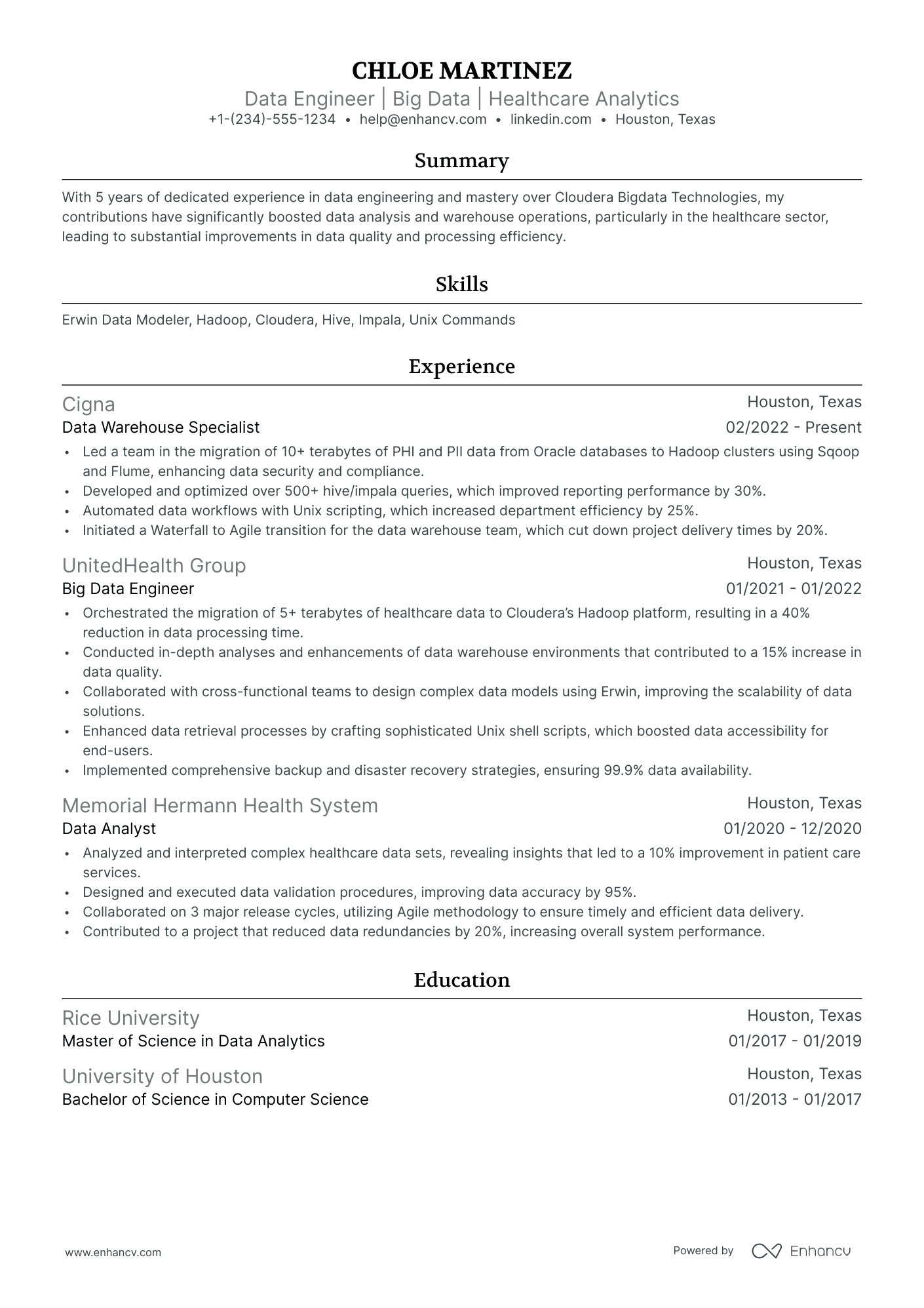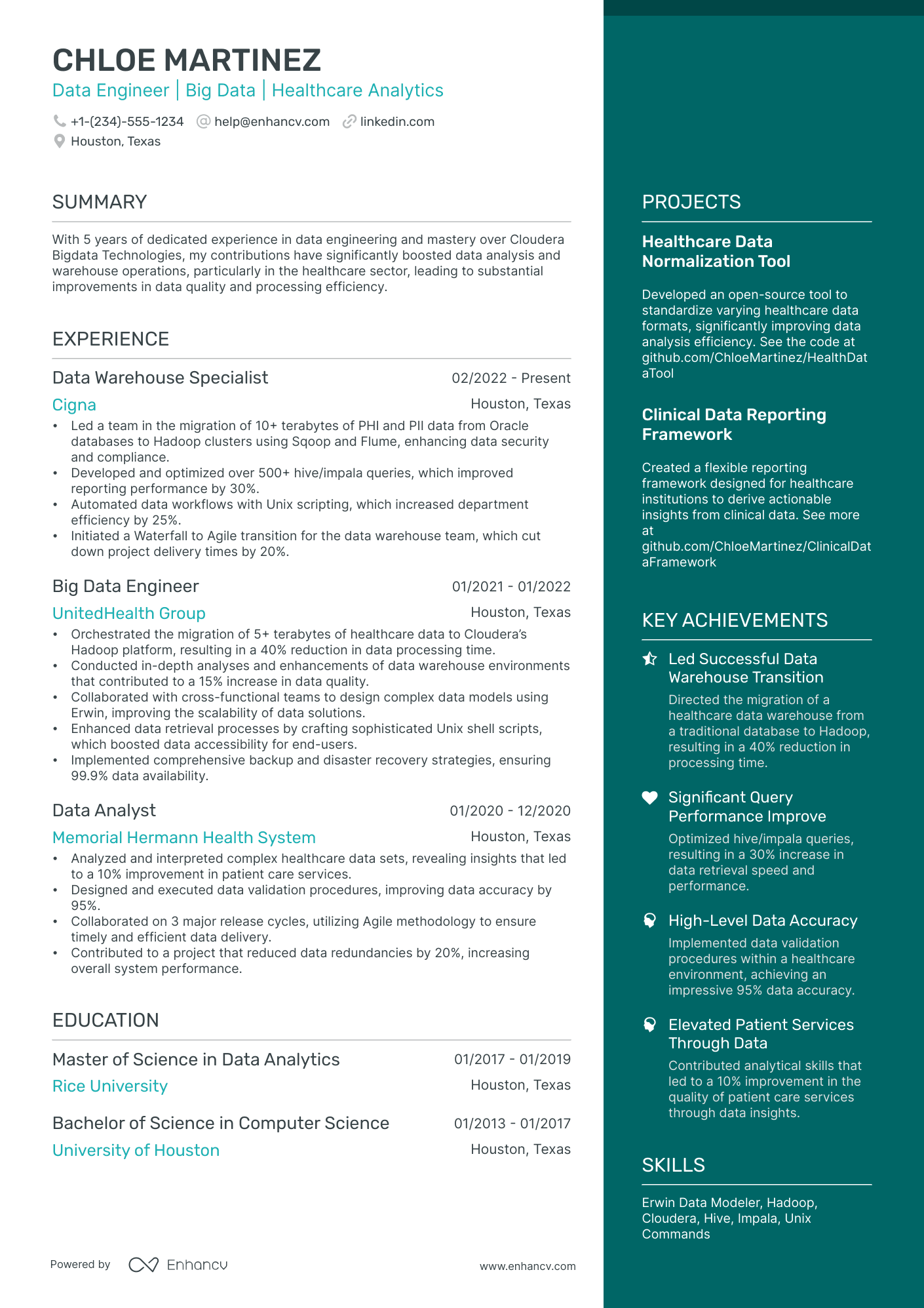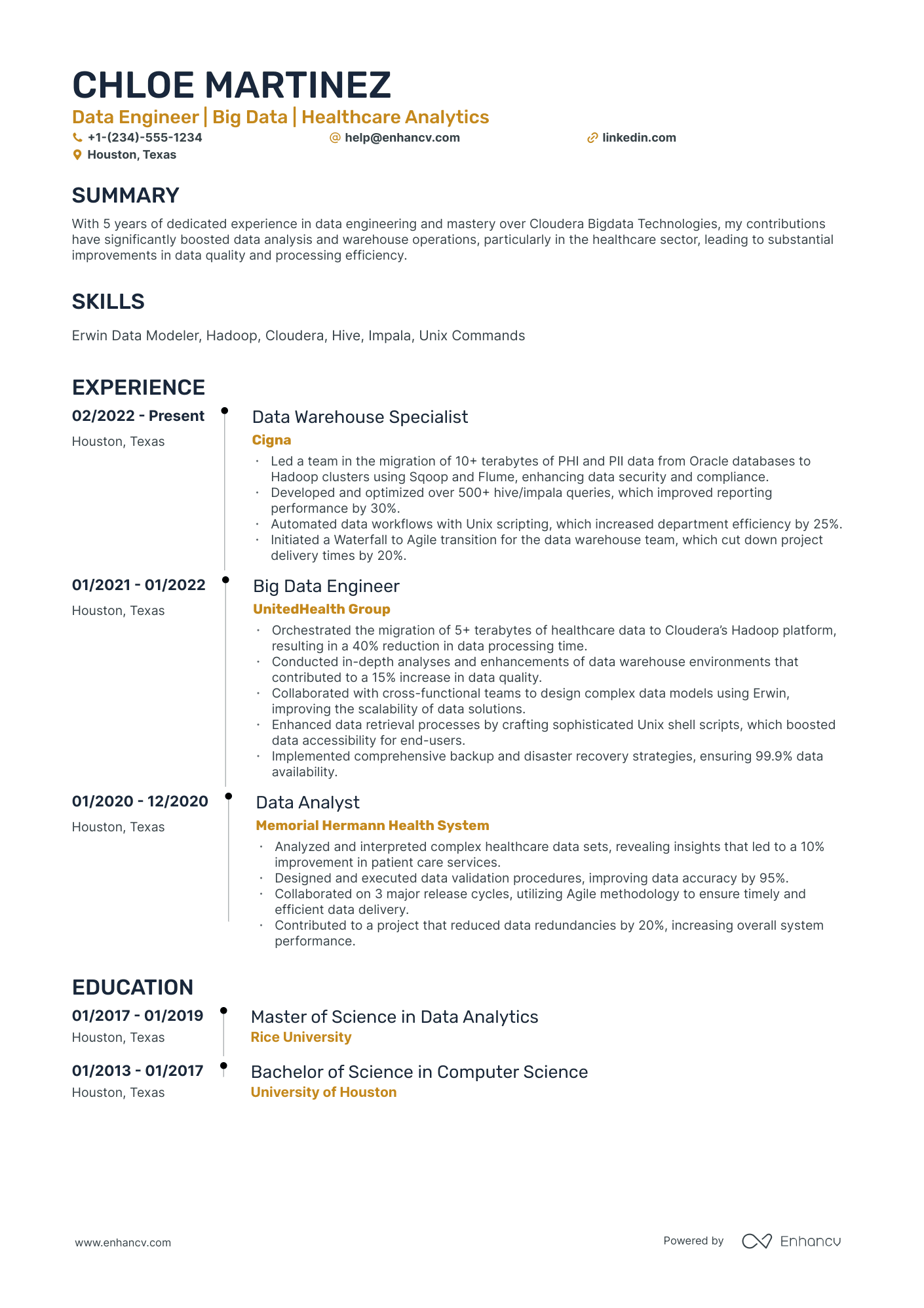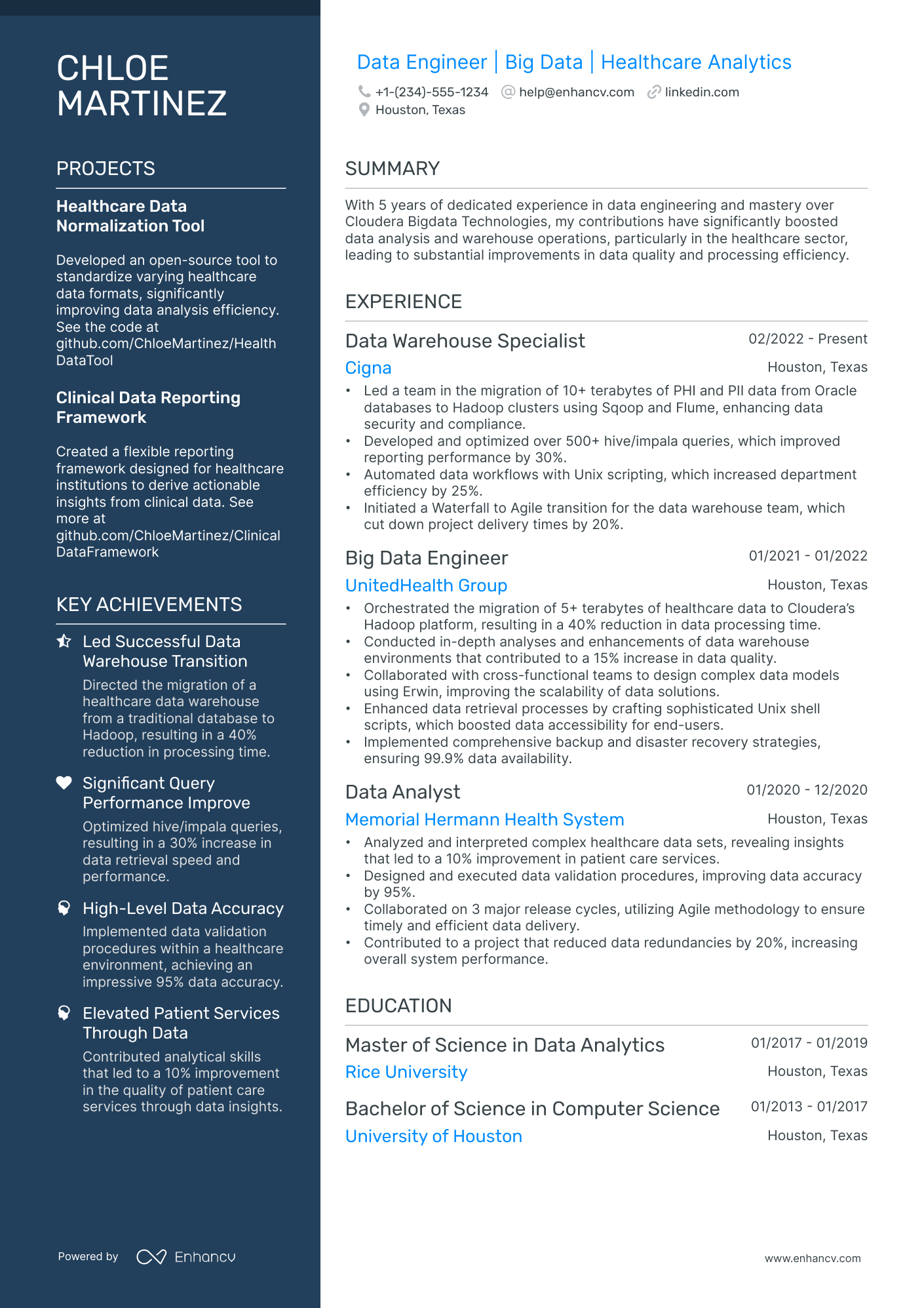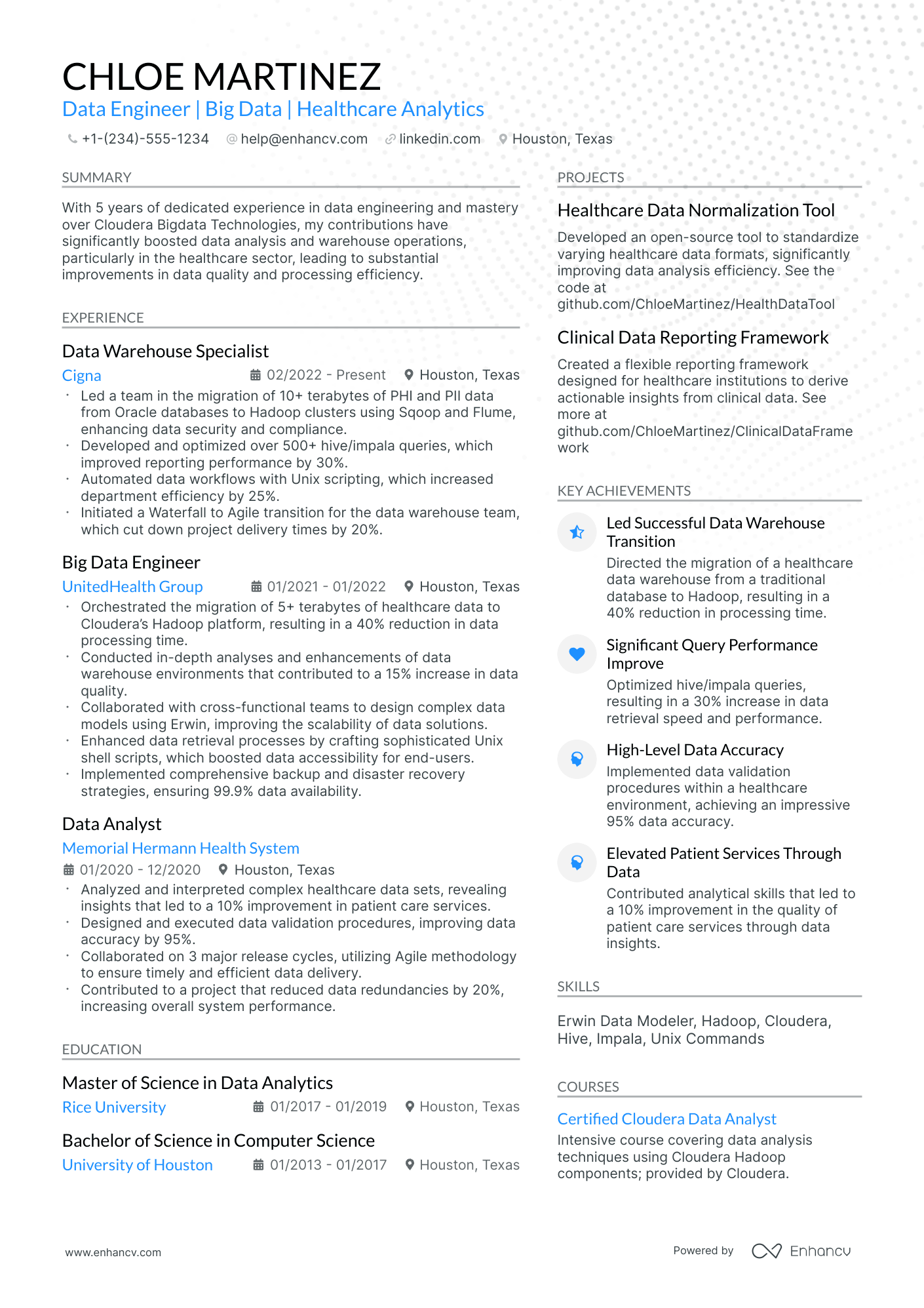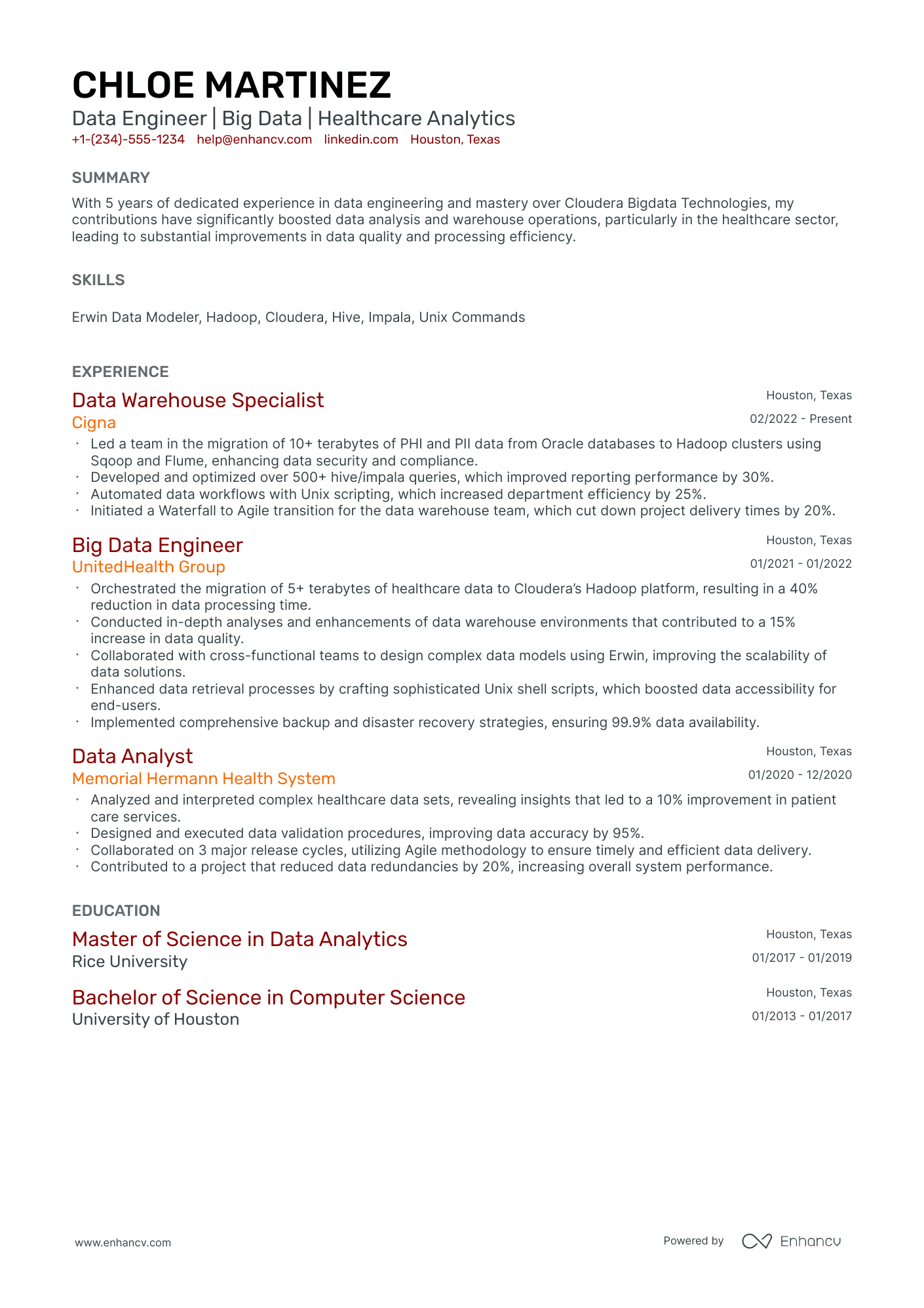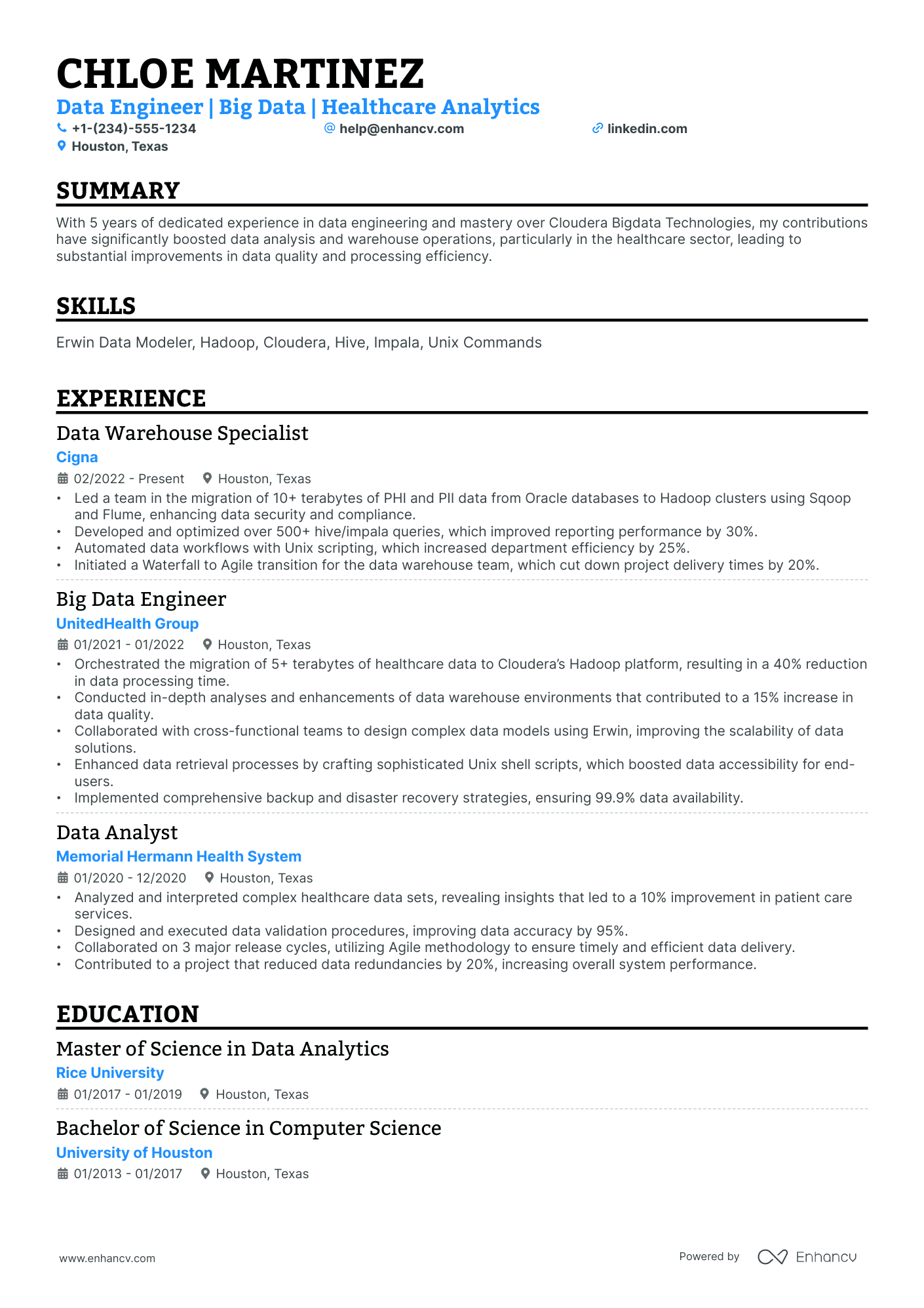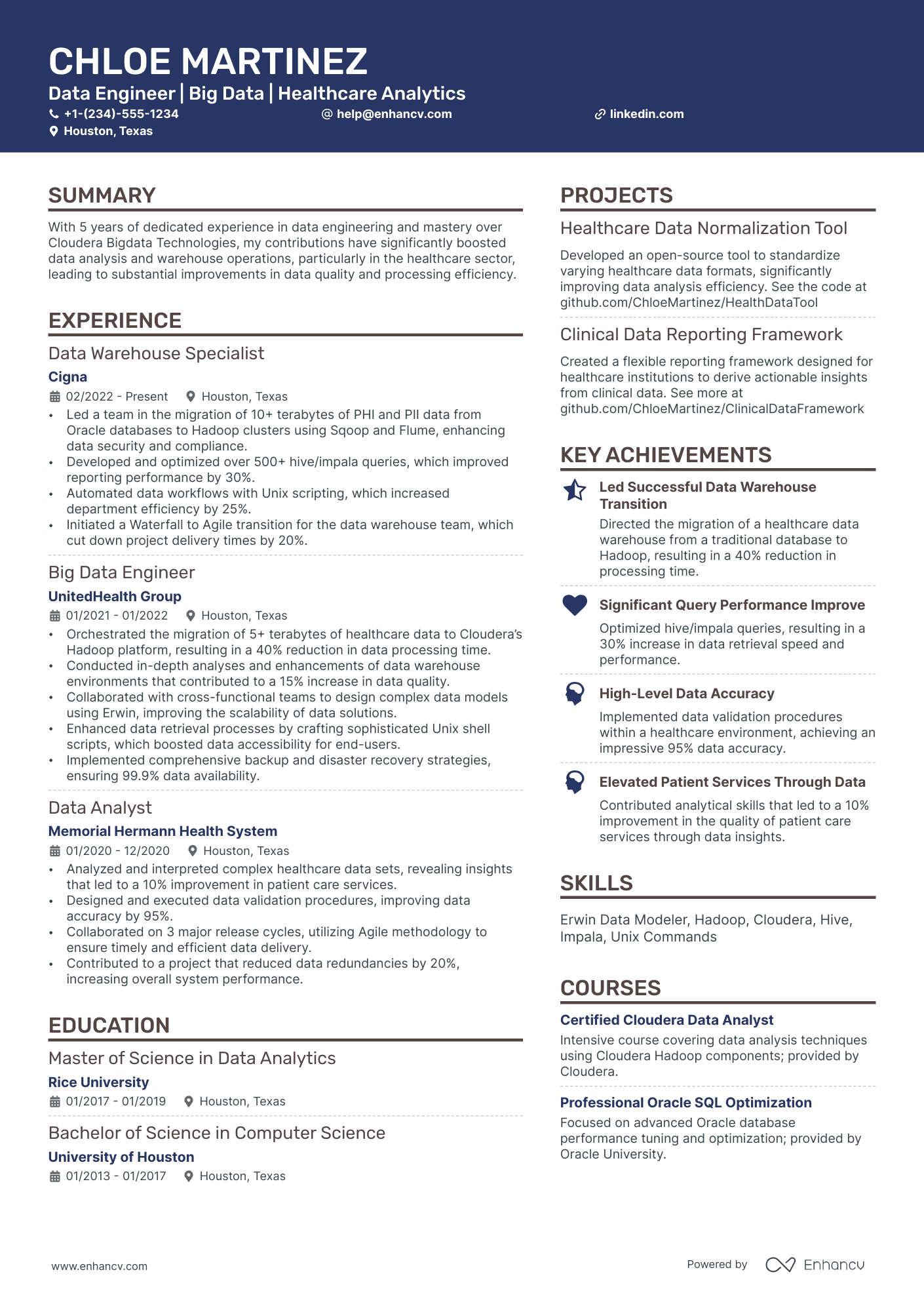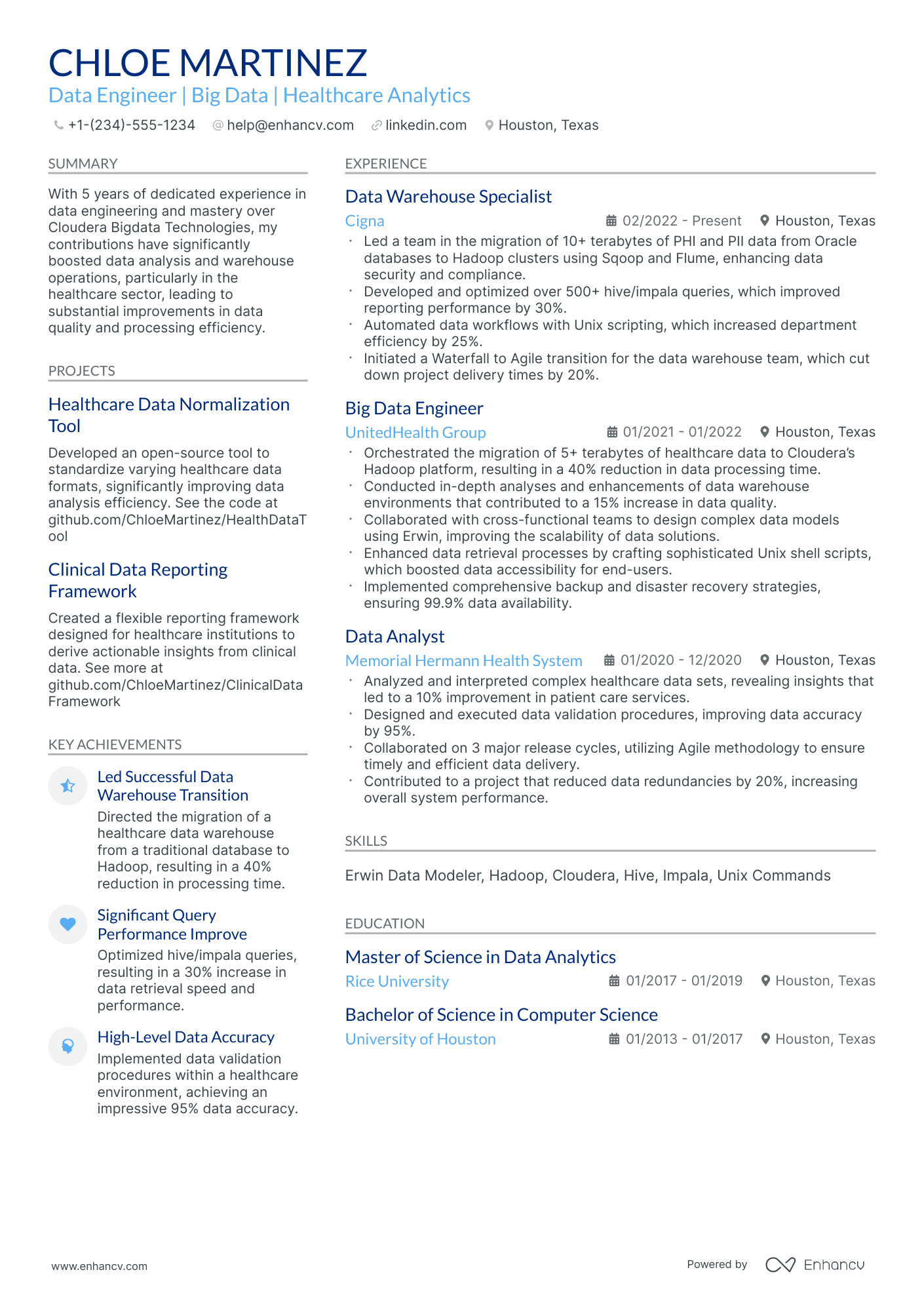As a database architect, articulating your complex technical projects and their impact on business outcomes can be a daunting resume challenge. Our guide provides structured advice to effectively translate your database achievements into compelling, result-driven bullet points that resonate with employers.
- Format your database architect resume to ensure that it balances professionalism with creativity, and follows the best practices.
- Match the database architect job requirements by including industry keywords on your resume.
- Use various resume sections to showcase your skills and achievements to answer why you're the best candidate for the database architect role.
Take inspiration from leading database architect resume examples to learn how to tailor your experience.
- Data Management Analyst Resume Example
- Marketing Data Analyst Resume Example
- Database Manager Resume Example
- Oracle Database Administrator Resume Example
- Clinical Data Analyst Resume Example
- Data Warehouse Engineer Resume Example
- Database Engineer Resume Example
- Azure Data Engineer Resume Example
- Data Entry Analyst Resume Example
- Healthcare Data Analyst Resume Example
Best practices for the look and feel of your database architect resume
Before you even start writing your database architect resume, first you need to consider its layout and format.
What's important to keep in mind is:
- The reverse-chronological resume is the most widely used format to present your experience, starting with your latest job.
- Your database architect resume header needs to include your correct, professional contact details. If you happen to have a professional portfolio or an updated LinkedIn profile, include a link to it.
- Ensure your resume is no longer than two pages - you don't have to include irelevant experience on your resume just to make it look longer.
- Unless specified otherwise, submit your resume in the most popular format, the PDF one, as this will ensure your database architect resume isn't altered.
Different regions expect different formats – Canadian resumes, for example, may look unique.
Upload & Check Your Resume
Drop your resume here or choose a file. PDF & DOCX only. Max 2MB file size.
PRO TIP
If you happen to have plenty of certificates, select the ones that are most applicable and sought-after across the industry. Organize them by relevance to the role you're applying for.
Traditional sections, appreciated by recruiters, for your database architect resume:
- Clear and concise header with relevant links and contact details
- Summary or objective with precise snapshot of our career highlights and why you're a suitable candidate for the database architect role
- Experience that goes into the nuts and bolts of your professional qualifications and success
- Skills section(-s) for more in-depth talent-alignment between job keywords and your own profile
- Education and certifications sections to further show your commitment for growth in the specific niche
What recruiters want to see on your resume:
- Proficiency in database management systems and modeling tools, such as Oracle, SQL Server, MySQL, PostgresQL, and NoSQL databases like MongoDB, Cassandra, or DynamoDB.
- Demonstrated experience with data architecture design, including data partitioning, replication, sharding, and database schema design that ensures scalability and performance.
- Knowledge of ETL processes, data warehousing, data lakes, and data integration patterns relevant to enterprise data management.
- Experience with cloud database technologies and services such as AWS RDS, Azure SQL Database, Google Cloud SQL, and familiarity with implementing cloud-based disaster recovery and high availability strategies.
- Understanding of compliance and security standards relevant to data storage and management, like GDPR, HIPAA, and knowledge of implementing robust database security measures.
Writing your database architect resume experience
Within the body of your database architect resume is perhaps one of the most important sections - the resume experience one. Here are five quick tips on how to curate your database architect professional experience:
- Include your expertise that aligns to the job requirements;
- Always ensure that you qualify your achievements by including a skill, what you did, and the results your responsibility led to;
- When writing each experience bullet, ensure you're using active language;
- If you can include a personal skill you've grown, thanks to your experience, this would help you stand out;
- Be specific about your professional experience - it's not enough that you can "communicate", but rather what's your communication track record?
Wondering how other professionals in the industry are presenting their job-winning database architect resumes? Check out how these database architect professionals put some of our best practices into action:
- Led the design of a new cloud-based database infrastructure using AWS services, enhancing the scalability and performance for a 4-million-user platform.
- Implemented comprehensive data security protocols that decreased the company's risk of data breaches by 30% through regular audits and updates.
- Collaborated with cross-functional teams to integrate database systems with enterprise applications, improving data access and utilization by 25%.
- Developed a distributed database system for high-volume transaction processing, which supported a 40% increase in transactional throughput.
- Conducted a complete overhaul of legacy database structures, which improved data retrieval efficiency and reduced server load times by 20%.
- Authored and maintained extensive documentation on database architecture and development processes, streamlining onboarding for new team members.
- Architected a SQL Server database migration to Azure SQL, leading to a 50% reduction in operational costs due to cloud optimization.
- Designed and implemented a business intelligence solution that enabled data-driven decisions, increasing revenue by 15% through targeted marketing strategies.
- Optimized stored procedures and database queries, which resulted in a 35% improvement in application response times.
- Played a pivotal role in the design of a company-wide ETL process that consolidated disparate data sources into a unified data warehouse.
- Provided mentorship and technical guidance to a team of junior database architects, improving team performance and project delivery timelines by 20%.
- Initiated proactive database performance tuning initiatives that increased overall system stability and uptime by 99.9%.
- Crafted a custom NoSQL database solution to handle unstructured data for a large-scale social media analytics platform, processing over 2 TB of data daily.
- Spearheaded the integration of Big Data technologies with traditional RDBMS, enhancing predictive analytics capabilities for the company's flagship products.
- Devised an innovative multi-tenancy database schema for a SaaS application, which supported 500+ clients without compromising performance or security.
- Orchestrated the transition to an in-memory database system, reducing data access latency by over 70% for critical financial applications.
- Established and enforced data governance standards across all departments, assuring compliance with industry and federal regulations.
- Automated database backup and recovery processes, saving the team 15 hours per week and increasing data reliability.
- Directed a team of database professionals in the deployment of a distributed ledger technology for secured transaction recording in a fintech environment.
- Key contributor to the re-architecting of the data model for a CRM system, which led to a 25% improvement in sales forecasting accuracy.
- Enabled real-time data analysis by integrating streaming data pipelines with the existing data warehouse architecture.
- Created a robust data replication strategy ensuring zero data loss and 99.99% availability across global data centers for a multinational corporation.
- Facilitated a 40% faster data retrieval rate by re-designing database indexing strategies, directly impacting customer satisfaction and retention.
- Engaged in strategic planning sessions with executive leadership to align database strategies with the long-term vision and business objectives.
The following content includes information from "O*NET OnLine" by the U.S. Department of Labor, Employment and Training Administration (USDOL/ETA). Used under the CC BY 4.0 license. The data represents the top responsibilities present on the task lists for database architect professionals.
Top Responsibilities for Database Architect:
- Develop and document database architectures.
- Collaborate with system architects, software architects, design analysts, and others to understand business or industry requirements.
- Develop database architectural strategies at the modeling, design and implementation stages to address business or industry requirements.
- Design databases to support business applications, ensuring system scalability, security, performance, and reliability.
- Develop data models for applications, metadata tables, views or related database structures.
- Design database applications, such as interfaces, data transfer mechanisms, global temporary tables, data partitions, and function-based indexes to enable efficient access of the generic database structure.
- Develop methods for integrating different products so they work properly together, such as customizing commercial databases to fit specific needs.
- Create and enforce database development standards.
- Document and communicate database schemas, using accepted notations.
- Develop data model describing data elements and their use, following procedures and using pen, template or computer software.
Quantifying impact on your resume
- Include the number of databases designed and their respective sizes and scalability metrics, showcasing your capability to handle complex and large-scale systems.
- List the percentage of performance improvement in database systems you've engineered, demonstrating your ability to optimize and enhance operations.
- Specify the reduction in data retrieval times due to your optimization efforts, highlighting your efficiency in speeding up essential database operations.
- Mention the amount of cost savings achieved through better database architecture, indicating your contribution to the financial health of the business.
- Describe the volume of data your database solutions can handle, suggesting your foresight for future growth and data scalability.
- Detail quantifiable improvements in data integrity and error reduction, ensuring your commitment to data quality and consistency.
- Outline the number of successful database migrations or integrations you've completed, showing your skill in executing complex transitions smoothly.
- Quantify the extent of increased data security measures in your designs, proving your attention to safeguarding sensitive information.
Action verbs for your database architect resume
Database architect resume without experience: a walk-through guide
If you don't happen to have any relevant experience yet, you can substitute this with:
- Short-term gigs and stunts - like month-long internships, that you have done during your university days
- Contract work - be specific about the relevance and outcomes of each role you include
- Resume format that prioritizes your skills - the functional-skill-based format or hybrid format could work
- Research roles - feature those especially prominently if you've participated in a noteworthy project or your role was of utmost importance to the project's success.
Recommended reads:
PRO TIP
If you failed to obtain one of the certificates, as listed in the requirements, but decide to include it on your resume, make sure to include a note somewhere that you have the "relevant training, but are planning to re-take the exams". Support this statement with the actual date you're planning to be re-examined. Always be honest on your resume.
Popular database architect hard skills and soft skills for your resume
Apart from assessing your professional expertise, recruiters are on the lookout for whether your skills align with the job.
Your profile would thus be assessed in regard to your:
- Hard or technical skills - your ability to perform on the job using particular technologies or software
- Soft skills - how you adapt, communicate, and thrive in different environments.
Both types of skills - hard and soft skills - are important for your resume, so make sure to create a dedicated skills section that:
- Lists up to five or six skills that align with the job advert.
- Integrates vital keywords for the industry, but also reflects on your personal strengths.
- Builds up further your skills with an achievements section within which you explain what you've achieved thanks to using the particular skill.
- Aims to always quantify in some way how you've used the skill, as it's not enough to just list it.
What are the most sought out hard and soft skills for database architect roles?
Check out the industry's top choices with our two dedicated lists below:
Top skills for your database architect resume:
SQL
NoSQL
Database Design
Data Modeling
ETL Processes
Database Management Systems (DBMS)
Cloud Databases (e.g., AWS RDS, Azure SQL)
Performance Tuning
Data Warehousing
Backup and Recovery Solutions
Problem Solving
Communication
Attention to Detail
Collaboration
Analytical Thinking
Time Management
Adaptability
Critical Thinking
Leadership
Project Management
Next, you will find information on the top technologies for database architect professonals from "O*NET OnLine" by the U.S. Department of Labor, Employment and Training Administration (USDOL/ETA). Used under the CC BY 4.0 license.
Top technologies for Database Architect’s resume:
- Amazon DynamoDB
- Elasticsearch
- Apache Hive
- Blackboard software
- React
- Spring Framework
PRO TIP
Highlight any significant extracurricular activities that demonstrate valuable skills or leadership.
Database architect-specific certifications and education for your resume
Place emphasis on your resume education section . It can suggest a plethora of skills and experiences that are apt for the role.
- Feature only higher-level qualifications, with details about the institution and tenure.
- If your degree is in progress, state your projected graduation date.
- Think about excluding degrees that don't fit the job's context.
- Elaborate on your education if it accentuates your accomplishments in a research-driven setting.
On the other hand, showcasing your unique and applicable industry know-how can be a literal walk in the park, even if you don't have a lot of work experience.
Include your accreditation in the certification and education sections as so:
- Important industry certificates should be listed towards the top of your resume in a separate section
- If your accreditation is really noteworthy, you could include it in the top one-third of your resume following your name or in the header, summary, or objective
- Potentially include details about your certificates or degrees (within the description) to show further alignment to the role with the skills you've attained
- The more recent your professional certificate is, the more prominence it should have within your certification sections. This shows recruiters you have recent knowledge and expertise
At the end of the day, both the education and certification sections hint at the initial and continuous progress you've made in the field.
And, honestly - that's important for any company.
Below, discover some of the most recent and popular database architect certificates to make your resume even more prominent in the applicant pool:
The top 5 certifications for your database architect resume:
- Oracle Certified Professional, MySQL 5.7 Database Administrator (OCP) - Oracle
- Microsoft Certified: Azure Data Fundamentals (DP-900) - Microsoft
- IBM Certified Database Administrator – DB2 - IBM
- Certified Data Management Professional (CDMP) - DAMA International
- Amazon Web Services (AWS) Certified Database - Specialty - Amazon Web Services (AWS)
The content below includes information from "O*NET OnLine" by the U.S. Department of Labor, Employment and Training Administration (USDOL/ETA). Used under the CC BY 4.0 license. The data represents the top associations for database architect professionals.
Top US associations for a Database Architect professional
- Higher Education Data Warehousing
- Institute for Certification of Computing Professionals
- Association for Computing Machinery
- CompTIA
- Computing Research Association
PRO TIP
If you're in the process of obtaining your certificate or degree, list the expected date you're supposed to graduate or be certified.
Recommended reads:
Professional summary or objective for your database architect resume
database architect candidates sometimes get confused between the difference of a resume summary and a resume objective.
Which one should you be using?
Remember that the:
- Resume objective has more to do with your dreams and goals for your career. Within it, you have the opportunity to showcase to recruiters why your application is an important one and, at the same time, help them imagine what your impact on the role, team, and company would be.
- Resume summary should recount key achievements, tailored for the role, through your career. Allowing recruiters to quickly scan and understand the breadth of your database architect expertise.
The resume objectives are always an excellent choice for candidates starting off their career, while the resume summary is more fitting for experienced candidates.
No matter if you chose a summary or objective, get some extra inspiration from real-world professional database architect resumes:
Resume summaries for a database architect job
- Seasoned database architect with over 10 years' experience in high-stakes environments, proficient in Oracle, MySQL, and MongoDB. Successfully designed a fault-tolerant database infrastructure for a global financial firm, leading to a 40% increase in data processing efficiency.
- Diligent database architect with 12 years in creating scalable database solutions, specializing in SQL Server and ETL processes. Architected a cloud migration strategy for a Fortune 500 company, cutting operational costs by 20% and improving data recovery times by 30%.
- Former Software Developer with 8 years of experience, adept in Java and C#. Now transitioning to database architecture, eager to apply my problem-solving skills and technical prowess to managing complex database systems and optimizing data functions for enhanced performance.
- IT Specialist with 6 years focusing on network infrastructure, pivoting towards a career as a database architect. Strong foundational knowledge in data structures and algorithms, committed to mastering database design and management to ensure robust and secure data storage solutions.
- Keen to embark on a career as a database architect, bringing a fresh perspective and deep curiosity in advanced data sorting techniques. Dedicated to acquiring hands-on experience with SQL, NoSQL databases, and data warehousing concepts to contribute to cutting-edge data solutions.
- Aspiring database architect with a background in data analysis, seeking to leverage my 5 years of data-focused expertise into designing sophisticated data storage solutions. Motivated to learn from industry leaders and to master database optimization and security for enhancing organizational data infrastructure.
Average salary info by state in the US for database architect professionals
Local salary info for Database Architect.” Source: My Next Move, National Center for O*NET Development. Accessed 10/15/2024
| State | Average Salary (in USD) |
|---|---|
| US National Average | $134,700 |
| California (CA) | $162,250 |
| Texas (TX) | $138,090 |
| Florida (FL) | $123,960 |
| New York (NY) | $142,230 |
| Pennsylvania (PA) | $125,790 |
| Illinois (IL) | $128,990 |
| Ohio (OH) | $127,230 |
| Georgia (GA) | $155,210 |
| North Carolina (NC) | $125,860 |
| Michigan (MI) | $122,700 |
Showcasing your personality with these four database architect resume sections
Enhance your database architect expertise with additional resume sections that spotlight both your professional skills and personal traits. Choose options that not only present you in a professional light but also reveal why colleagues enjoy working with you:
- My time - a pie chart infographic detailing your daily personal and professional priorities, showcasing a blend of hard and soft skills;
- Hobbies and interests - share your engagement in sports, fandoms, or other interests, whether in your local community or during personal time;
- Quotes - what motivates and inspires you as a professional;
- Books - indicating your reading and comprehension skills, a definite plus for employers, particularly when your reading interests align with your professional field.
Key takeaways
- Invest in a concise database architect professional presentation with key resume sections (e.g. header, experience, summary) and a simple layout;
- Ensure that the details you decide to include in your resume are always relevant to the job, as you have limited space;
- Back up your achievements with the hard and soft skills they've helped you build;
- Your experience could help you either pinpoint your professional growth or focus on your niche expertise in the industry;
- Curate the most sought-after certifications across the industry for credibility and to prove your involvement in the field.
